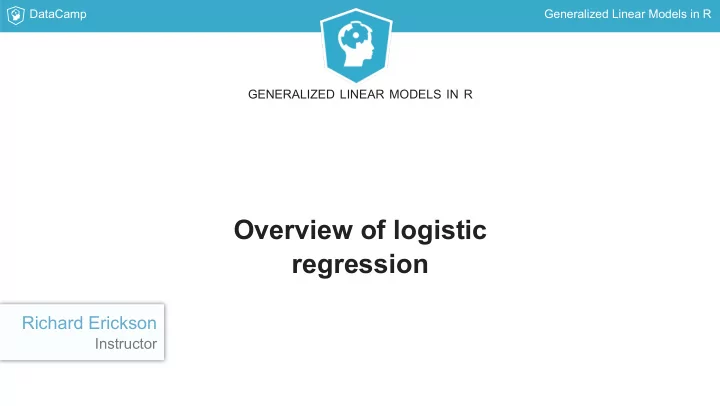

DataCamp Generalized Linear Models in R GENERALIZED LINEAR MODELS IN R Overview of logistic regression Richard Erickson Instructor
DataCamp Generalized Linear Models in R
DataCamp Generalized Linear Models in R
DataCamp Generalized Linear Models in R
DataCamp Generalized Linear Models in R Chapter overview Overview of logistic regression Inputs for logistic regression in R Link functions
DataCamp Generalized Linear Models in R Why use logistic regression? Binary data: (0/1) Survival data: Alive/dead Choices or behavior: Yes/No, Coke/Pepsi, etc. Result: Pass/fail, Heads/tails, Win/lose etc.
DataCamp Generalized Linear Models in R What is logistic regression? Default GLM for binomial family Model of binary data Y = Binomial( p ) Linked to linear equation logit( p ) = β + β x + ϵ 0 1
DataCamp Generalized Linear Models in R Logit function Logit defined as p ) ( 1− p logit( p ) = log Inverse logit defined as −1 1 logit ( x ) = 1+exp(− x )
DataCamp Generalized Linear Models in R How to run logistic regression Function: glm(y ~ x, data = dat, family = 'binomial') Inputs: y = c(0, 1, 0, 0, 1...) y = c("yes", "no"...) y = c("win", "lose"...) # Or any 2-level factor
DataCamp Generalized Linear Models in R Riding the bus? What makes people more likely to commute using a bus? Ride bus: yes , Not-ride bus no Do number of commuting days change the chance of riding the bus? 2015 commuter data from Pittsburgh, PA, USA CommuteDays Bus 1 5 Yes 2 2 No
DataCamp Generalized Linear Models in R GENERALIZED LINEAR MODELS IN R Let's practice!
DataCamp Generalized Linear Models in R GENERALIZED LINEAR MODELS IN R Bernoulli versus binomial distribution Richard Erickson Instructor
DataCamp Generalized Linear Models in R Foundation of GLM Binomial and Bernoulli foundation of logistic regression Closely related to data input
DataCamp Generalized Linear Models in R Bernoulli distribution Binary outcome: e.g., single coin flip Expected probability k outcomes with p probability 1− k f ( k , p ) = p (1 − p ) k Example of flipping 1 coin
DataCamp Generalized Linear Models in R Binomial distribution Discrete outcome: e.g., flipping multiple coins Expected probability n trials k outcomes with p probability n ) k n − k f ( k , n , p ) = p (1 − p ) ( k Flipping 4 coins at once
DataCamp Generalized Linear Models in R Simulating in R rbinom(n = , size = , p = ) n : Number of random numbers to generate size : Number of trials p : Probability of "success" size = 1 : Bernoulli
DataCamp Generalized Linear Models in R GLM inputs options Long format (Bernoulli format) Wide format (Binomial format) Matrix: cbind(success, failure) y = c(0,1,...) Allows for variables for each Proportion of success: y = c(0.3, observation 0.1,...) with weights = c(1, 3, 2...) Looks at "groups" rather than individuals
DataCamp Generalized Linear Models in R Example Long data: Wide data: One entry per row One group per row Predictors for each response Predictors for each group response treatment length group dead alive Total groupTemp dead a 3.471006 a 12 2 14 high dead a 3.704329 b 3 11 14 low alive a 2.043244 alive b 1.667343
DataCamp Generalized Linear Models in R Which input method to use? What is your raw data structure? Long or wide? What variables do I have? Individual or group? Do want to make inferences about groups or individuals?
DataCamp Generalized Linear Models in R GENERALIZED LINEAR MODELS IN R Let's practice!
DataCamp Generalized Linear Models in R GENERALIZED LINEAR MODELS IN R Link functions- Probit compared to logit Richard Erickson Instructor
DataCamp Generalized Linear Models in R Why link functions? Understand and simulate GLMs Probit vs logit as example
DataCamp Generalized Linear Models in R Why probit? Demonstrate link function Used in some fields (e.g., toxicology) Preferred by some people
DataCamp Generalized Linear Models in R What is a probit? Pro bability un it Toxicology by Chester Bliss in 1934 Computationally easier than logit Model know as probit analysis, probit regression, or probit model
DataCamp Generalized Linear Models in R Probit equation Model of binary data Y = Binomial( p ) Linked to linear equation −1 Φ ( p ) = β + β x + ϵ 0 1
DataCamp Generalized Linear Models in R Probit function Based upon cumulative normal 2 1 1 − z z Φ( z ) = ∫ −∞ e dz 2 √ 2 π
DataCamp Generalized Linear Models in R
DataCamp Generalized Linear Models in R Fitting a probit in R family option for glm() Character: glm(..., family = "binomial") Function: glm(..., family = binomial() ) Default: binomial(link = "logit") Probit: binomial(link = "probit") Match instructions for DataCamp
DataCamp Generalized Linear Models in R Simulate with probit Convert from probit scale to probability scale: p = pnorm(-0.2) Use probability with binomial distribution rbinom(n = 10, size = 1, prob = p)
DataCamp Generalized Linear Models in R Simulate with logit Convert from logit scale to probability scale: p = plogis(-.2) Use probability with a binomial distribution rbinom(n = 10, size = 1, prob = p)
DataCamp Generalized Linear Models in R When to use probit vs logit? Largely domain specific Thicker tails of logit Either is tenable
DataCamp Generalized Linear Models in R GENERALIZED LINEAR MODELS IN R Let's practice!
Recommend
More recommend